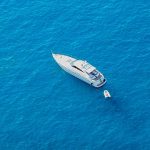The International Maritime Organization (IMO) number is a unique identifier for ships and for registered ship management companies. For ships, it consists of the three letters “IMO” followed by the seven-digit number assigned to all ships by IHS Fairplay constructed. This is a unique seven digit number that is assigned to propelled, sea-going merchant ships of 100 gross tons and above. It serves to identify ships and is not changed when the ship’s owner, country of registry or name changes. For ship management companies, the IMO number consists of the three letters “IMO”, followed by a seven-digit number. For example, IMO 8814275 refers to the ship Eendracht (See insert picture).
Definition
The IMO ship identification number is made of the three letters “IMO” followed by the seven-digit number assigned to all ships by IHS Fairplay (formerly known as Lloyd’s Register-Fairplay) when constructed. This is a unique seven digit number that is assigned to propelled, all passenger ships of 100 GT and above and cargo ships of 300 gross tonnage and above, upon keel laying with the exception of the following:
– Vessels solely engaged in fishing
– Ships without mechanical means of propulsion
– Pleasure yachts
– Ships engaged on special service (e.g. lightships, SAR vessels)
– Hopper barges
– Hydrofoils, air cushion vehicles
– Floating docks and structures classified in a similar manner
– Ships of war and troopships
– Wooden ships
The integrity of an IMO number can be verified by its check digit, which is the rightmost digit. This is done by multiplying each of the leftmost six digits by a factor corresponding to their position from right to left, and adding those products together. The rightmost digit of this sum is the check digit.
IMO SHIP IDENTIFICATION NUMBER SCHEME

The IMO ship identification number scheme was introduced in 1987 through adoption of resolution A600(15), as a measure aimed at enhancing “maritime safety, and pollution prevention and to facilitate the prevention of maritime fraud”. It aimed at assigning a permanent number to each ship for identification purposes. That number would remain unchanged upon transfer of the ship to other flag(s) and would be inserted in the ship’s certificates. When made mandatory, through SOLAS regulation XI/3 (adopted in 1994), specific criteria of passenger ships of 100 gross tonnage and upwards and all cargo ships of 300 gross tonnage and upwards were agreed.
The implementation of the scheme became mandatory for all ships as of 1 January 1996.
In December 2002, the Diplomatic Conference on Maritime Security adopted a number of measures aimed at enhancing security of ships and port facilities. This included a modification to SOLAS Regulation XI-1/3 to require ships’ identification numbers to be permanently marked in a visible place either on the ship’s hull or superstructure. Passenger ships should carry the marking on a horizontal surface visible from the air. (See insert picture) Ships should also be marked with their ID numbers internally.
The IMO ship identification number is made of the three letters “IMO” followed by the seven-digit number assigned to all ships by IHS Fairplay (formerly known as Lloyd’s Register-Fairplay) when constructed.
This is a unique seven digit number that is assigned to propelled, sea-going merchant ships of 100 GT and above upon keel laying with the exception of the following:
– Vessels solely engaged in fishing
– Ships without mechanical means of propulsion
– Pleasure yachts
– Ships engaged on special service (e.g. lightships, SAR vessels)
– Hopper barges
– Hydrofoils, air cushion vehicles
– Floating docks and structures classified in a similar manner
– Ships of war and troopships
– Wooden ships
This number is assigned to the total portion of the hull enclosing the machinery space and is the determining factor should additional sections be added.
The IMO number is never reassigned to another vessel and is shown on the ship’s certificates.



Comments are closed